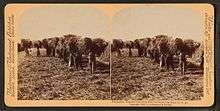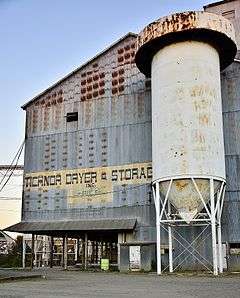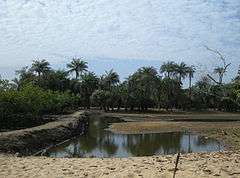Rice production in the United States


Rice production is important to the economy of the United States. Of the country's row crop farms, rice farms are the most capital-intensive, and have the highest national land rental rate average. In the US, all rice acreage requires irrigation. In 2000-09 approximately 3.1 million acres in the US were under rice production, while an increase is expected in the next decade to approximately 3.3 million acres.[1]US Rice represents rice producers in the six largest rice-producing states of Arkansas, California, Louisiana, Mississippi, Missouri, and Texas.[2][3]
History
Early history

Rice was introduced to the United States in the 17th century. It is mentioned to have been under cultivation in Virginia as far back as 1609, although it is reported that one bushel of rice had been sent to the colony later, in the summer of 1671, on the cargo vessel William and Ralph. In 1685, a bag of Madagascar rice known as "Gold Seede" was given to Dr. Henry Woodward. A tax law of 26 September 1691 had permitted payment of taxes by the colonists by way of rice and other commodities.[4] [5]
The colonies of South Carolina and Georgia prospered and amassed great wealth from rice planting, based on the slave labor obtained from the Senegambia area of West Africa and from coastal Sierra Leone. One batch of slaves was advertised as "a choice cargo of Windward and Gold Coast Negroes, who have been accustomed to the planting of rice". At the port of Charleston, through which 40% of all American slave imports passed, slaves from Africa brought the highest prices in recognition of their prior knowledge of rice culture, which was put to use on the many rice plantations around Georgetown, Charleston, and Savannah.[4]

Enslaved Africans cleared the land, dyked the marshes and built the irrigation system, skimming the freshwater layer off the high tide, flushing the fields, and adjusting the water level to the development stage of the rice. Rice was planted, hoed, and harvested with hand tools; plows and harvest wains could be pulled by mules or oxen wearing special shoes.[4] At first rice was milled by hand with wooden paddles, then winnowed in sweetgrass baskets (the making of which was another skill brought by slaves from Africa). The invention of the rice mill increased profitability of the crop, and the addition of water power for the mills in 1787 by American millwright Jonathan Lucas was another step forward.
Rice production was not merely unhealthy but lethal. One 18th-century writer wrote:[4]
If a work could be imagined peculiarly unwholesome and even fatal to health, it must be that of standing like the negroes, ankle and mid-leg deep in water which floats an ouzy mud, and exposed all the while to a burning sun which makes the air they breathe hotter than the human blood; these poor wretches are then in a furness of stinking putrid effluvia.
Inadequate food, housing, and clothing, malaria, yellow fever, poisonous snakes, alligators, hard labour, and brutal treatment killed up to a third of Low Country slaves within a year. Not one child in ten lived to age sixteen. However, in the 1770s, a slave could produce rice worth more than six times his or her own market value in a year, so this high death rate was not uneconomical for their owners. Rice plantations could produce profits of up to 26 percent per year. Runaways, on the other hand, were a problem:[4]
I gave them a hundred lashes more than a dozen times; but they never quit running away, till I chained them together, with iron collars round their necks, and chained them to spades, and made them do nothing but dig ditches to drain the rice swamps. They could not run away then, unless they went together, and carried their chains and spades with them. I kept them in this way two years....
- — one overseer's method of controlling slaves, reported by fugitive slave Charles Ball
Most plantations were run on the task system, where a slave was given one or more tasks, estimated at ten hours' hard work, each day. After they had finished the tasks to the overseer's satisfaction, they could spend the remainder of the day as they chose, often on growing their food, spinning, sewing their clothes, or building their houses (slaves were typically supplied with nails and five yards of cloth per year). The task system, and the unwillingness of free people to live in rice-growing areas, may have led to the greater survival of African culture among the Gullah.[4]
In the country's early years, rice production was limited to the South Atlantic and Gulf states. For almost the first 190 years of rice production in the US, the principal producers were South Carolina and Georgia. Limited amounts were grown in North Carolina, Florida, Alabama, Mississippi and Louisiana.[8]
19th century

Rice was introduced into the southern states of Louisiana and east Texas in the mid-19th century.[9] Meanwhile, soil fertility in the east fell, especially for inland rice.[4]
Emancipation in 1863 freed rice workers. East-coast rice farming required hard, skilled work under extremely unhealthy conditions, and without slave labour, profits fell. Increasing automation in response came too late, and a series of hurricanes that hit Carolina in the late 1800s and damaged levees put an end to the industry. Production shifted to the Deep South,[10] where the geography was more favourable to mechanization.[8]
These events can be seen in rice production statistics. In 1839, the total production was 80,841,422 pounds, of which 60,590,861 pounds were grown in South Carolina and 12,384,732 pounds in Georgia. In 1849, cultivation reached 215,313,497 pounds.[11] Between 1846 and 1861, annual rice production in North Carolina, South Carolina, and Georgia averaged more than 105 million pounds of cleaned rice, with South Carolina producing more than 75 percent.

At the census of 1870, after emancipation, the production of rice decreased to 73,635,021 pounds. In 1879, the total area devoted to rice was 174,173 acres, and the total production of clean rice was up again to 110,131,373 pounds. A decade later, the total area devoted to rice cultivation was 161,312 acres, and the total production of clean rice equaled 128,590,934 pounds; this represented a 16.76 percent increase in the amount produced, with a decrease of 7.38 percent in the area under cultivation.[11]
Between 1890 and 1900, Louisiana and Texas increased rice crop acreage to such an extent that they produced almost 75 percent of the country's product. Between 1866 and 1880, the annual production of the three States averaged just under 41 million pounds, of which South Carolina produced more than 50 percent. After 1880, their average annual production approximated 46 million pounds of cleaned rice, of which North Carolina produced 5.5 million, South Carolina 27 million and Georgia 13.5 million pounds.[8]
The rice industry in Louisiana began around the time of the Civil War. For a number of years, production was small, but during the 1870s the industry began to assume large proportions, averaging nearly 30 million pounds for the decade and exceeding 51 million pounds in 1880. In 1885, the production reached 100 million pounds, and in 1892, 182 million pounds. The great development of the rice industry in Louisiana after 1884 resulted from the opening up of a prairie region in the southwestern part of the state, and the development of a system of irrigation and culture which made possible the use of harvesting machinery similar to that used in the wheat fields of the Northwest, greatly reducing the costs of production. In 1896, yield from the Louisiana rice fields, where harvesting machinery was used, was good. However the milling process was not successful commercially in some rice varieties. The loss due to the milling process was considerable, particularly of the unbroken rice in the "head rice" variety.[8]
20th century to present

Rice was established in Arkansas in 1904, California in 1912, and the Mississippi Delta in 1942.[3] Rice cultivation in California in particular started during the California Gold Rush. It was introduced primarily for the consumption of about 40,000 Chinese laborers who were brought as immigrants to the state; only a small area was under rice cultivation to meet this requirement. However, commercial production began only in 1912 in the town of Richvale in Butte County.[12] Since then, California has cultivated rice in a big way, and as of 2006, its production of rice was the second largest in the United States.[13]
Production

Rice culture in the southeastern U.S. became less profitable with the loss of slave labor after the American Civil War, and it finally died out just after the turn of the 20th century. Today, people can visit the historic Mansfield Plantation in Georgetown, South Carolina, the state's only remaining rice plantation with the original mid-19th century winnowing barn and rice mill. The predominant strain of rice in the Carolinas was from Africa and was known as "Carolina Gold". The cultivar has been preserved and there are current attempts to reintroduce it as a commercially grown crop.[14]
In 1900, the annual production of rice in the US was approximately half the annual consumption. The two principal varieties of lowland rice which were cultivated in the Atlantic States were the "gold seed rice" and white rice, which were the original rice varieties introduced into the US. Gold seed rice was notable for the larger yield of the grain. It thus practically superseded white rice which was cultivated in the earlier years. Experiments with upland rice demonstrated that it could grow over large areas of the country but the crop's yield and quality are inferior to lowland rice produced by irrigation methods.[8]
(NRCS_Photo_Gallery).tif.png)
Since then, California has cultivated rice on a large scale, and as of 2006 its production was the second largest in the United States,[13] after Arkansas, with production concentrated in six counties north of Sacramento.[15]
During 2012, the estimated rice production was 199 million cwt, or 19.9 billion lbs. This was a rise of 8% over the production of 2011. The harvested area also recorded a rise from 2.68 million ha in 2012 to 2.7 million ha in 2013. Another record was of the yield during 2012 recorded at 7,449 pounds per acre, higher than the 2011 yield by 382 pounds per acre.[16]
Six states now account for over 99% of all rice grown in the US. These are Arkansas, California, Louisiana, Mississippi, Missouri and Texas. As of 2003, Arkansas topped the list with a production level of 213 million bushels against a total production of 443 million bushels in the country, and the annual per capita consumption reported is in excess of 28 pounds.[17]
Types of rice

The earliest types grown in Carolina were the African Oryza glaberrima, the prized "Carolina Gold". Asian Oryza sativa was "Carolina White".
After the total decline of rice cultivation in Carolina, "Carolina Gold" is now cultivated in Texas, Arkansas and Louisiana.[4]
In California, production is dominated by short and medium grain japonica varieties, including cultivars developed for the local climate such as Calrose, which makes up as much as 85% of the state's crop. The broad classification of rice grown includes Long Grain Rice, Medium Grain Rice and Short Grain Rice.[18]
While now more than 100 varieties of rice are grown in the world, in the US 20 varieties of rice are commercially produced, primarily in the states of Arkansas, Texas, Louisiana, Mississippi, Missouri, and California. Primary classification of rice grown are the long, medium or short grain type. The Long Grain Rice is slender and long, the Medium Grain Rice is plump but not round, and the Short Grain Rice is round. The forms of rice are Brown Rice, Parboiled Rice and Regular-Milled White Rice.[17][19]
The domestic utilization of rice in the US is food use (58%), while 16% is used in food and beer processing and 10% is used in pet food.[19]
Special varieties of rice such as jasmine rice and basmati rice which are of the aromatic variety are imported from Thailand, India, and Pakistan, as such varieties have not been evolved in the US; this demand for import is quite substantial and largely to meet the increasing population of the rice-eating ethnic community.[20]
Milling process
Harvested rice is subject to milling to remove the husk, which encloses the kernel. Before this process is started, the rice from the field is subject to a cleaning process to remove stalks and any extraneous material by means of special machinery. In the case of parboiled rice, a steam pressure process is adopted for milling. After drying, the rice is subjected to further processing to remove the hull and then polished. Brown rice is processed through a shelling machine which removes the hull. The resulting brown rice retains the brawn layer around the kernel. In the case of white rice, the hull and the brawn are removed and polished in a polishing machine, producing a polished kernel.[17]
Exports
The first export of rice from Carolina was 5 tons in 1698, which rose to 330 tons by 1700 and jumped to 42,000 tons in 1770. However, as a result of the abolition of slave labour, export from Carolina eventually ceased.[4]
While the rice production in the US accounts for about 2% of world production, its exports account for about 10% of all exports. The export is mostly of high-quality rice of the long and combined medium/short-grain varieties of rice. The type of rice exported is rough or unmilled rice, parboiled rice, brown rice, and fully milled rice. Exports to Mexico and Central America are mostly of the rough rice variety. Other countries to which the US exports rice include Mexico, Central America, Northeast Asia, the Caribbean, and the Middle East, Canada, the European Union (EU-27), and Sub-Saharan Africa.[20]
The exported variety is free of genetically enhanced (GE) rice. The World Trade Organization (WTO) and the North American Free Trade Agreement (NAFTA) are the agreements under which the US exports its rice and this has resulted in an increase of exports from the country since the 1990s.[20]
Culture

A popular festival observed on New Year's Day, by many Americans (mostly from the southern states) is the preparation and consuming of a rice cuisine called the "Hoppin' John", even though rice is not native to the US. Since rice is associated with slave labour as their staple diet (with horse-beans made in to a pulp by boiling; boiled yams and occasionally a small amount of beef or pork) it is eaten in the US on New Year's Day in the belief that it brings good luck since people who "eat poor New Year's Day, eat rich the rest of the year."[4]
The International Rice Festival is held every year in Crowley, Louisiana on Friday and Saturday of the third weekend in October. It is the largest and oldest agricultural festival of Louisiana. The festival is a celebration of rice as a staple food and its economic importance in the world.[21] The tradition was set in 1927 as a Rice Carnival by Sal Right, a pioneer of the rice industry. However, the celebration of this festival in Crowley is also attributed to Harry D Wilson, Commissioner of Agriculture. It is also said that the festival was the idea of the Governor to celebrate the festival on the occasion of the silver jubilee of establishment of the city of Crowley on 25 October 1937.[22]
See Also
References
- ↑ Baldwin, Katherine (April 2011). Consolidation and Structural Change in the U.S. Rice Sector. DIANE Publishing. pp. front cover, 11–. ISBN 978-1-4379-8478-1.
- ↑ "USA Rice". USA Rice. Retrieved 22 June 2013.
- 1 2 Kulp, Karel; Ponte, Jr., Joseph G. (2000). Handbook of Cereal Science and Technology. Marcel Dekker. pp. 203–. ISBN 978-0-8247-8294-8.
- 1 2 3 4 5 6 7 8 9 10 "Rice and Slavery in America". Slavery in America Organization. Archived from the original on January 1, 2007. Retrieved 24 June 2013.
- ↑ "The History of U.S. Rice Production - Part 1". Luisiana State University Ag Center. November 29, 2012.
- ↑ https://ricediversity.org/outreach/educatorscorner/documents/Carolina-Gold-Student-handout.pdf
- ↑ https://ricediversity.org/outreach/educatorscorner/documents/Carolina-Gold-Student-handout.pdf
- 1 2 3 4 5 Knapp, Seaman Ashahel (1900). Rice culture in the United States (Public domain ed.). U.S. Department of Agriculture. pp. 6–.
- ↑ "Farm Raised Crawfish". Crawfish.com. Retrieved 24 June 2013.
- ↑ http://www.learnnc.org/lp/editions/nchist-colonial/1875
- 1 2 United States. Census Office (1895). Reports on the statistics of agriculture in the United States: agriculture by irrigation in the western part of the United States, and statistics of fisheries in the United States at the eleventh census: 1890 (Public domain ed.). Government Printing Office. pp. 72–.
- ↑ Lee, Ching (2005). "Historic Richvale – the birthplace of California rice". California Farm Bureau Federation. Archived from the original on October 11, 2007. Retrieved 10 June 2013.
- 1 2 "California's Rice Growing Region". California Rice Commission. Archived from the original on February 10, 2006. Retrieved 27 June 2013.
- ↑ "Carolina Gold Rice Foundation". Carolina Gold Rice Foundation. Retrieved 24 June 2013.
- ↑ Sumner, Daniel A. & Brunke, Henrich (September 2003). "The economic contributions of the California rice industry". California Rice Commission. Archived from the original on April 26, 2006. Retrieved 25 June 2013.
- ↑ "Crop Production: 2012 Summary" (pdf). United States Department of Agriculture National Agricultural Statistics Service. Retrieved 25 June 2013.
- 1 2 3 "U.S. Rice Production". Riceland.com. Retrieved 25 June 2013.
- ↑ "Medium Grain Varieties". California Rice Commission. Archived from the original on May 8, 2006. Retrieved 25 June 2013.
- 1 2 "United States Department of Agriculture:Release No. 0306.06". U.S. RICE STATISTICS. August 2006.
- 1 2 3 "Trade". Rice exports. USDA Economic Research Service. Retrieved 25 June 2013.
- ↑ "About the Festival". Rice Festival.Com. Retrieved 25 June 2013.
- ↑ "Festival History". Rice Festival.com. Retrieved 25 June 2013.

